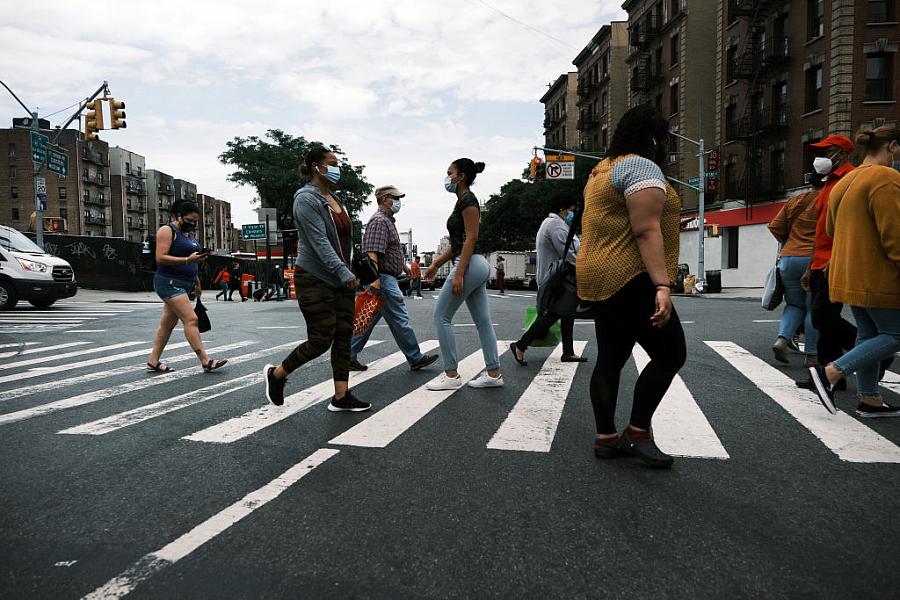In the Latino community, pandemic-fueled poverty triggers a silent crisis in mental health

(Photo by Spencer Platt/Getty Images)
Our Voice Nuestra Voz, a group that advocates for Spanish-speaking parents and the education of their children, meets online weekly to talk about challenges in school. But when the hour is up and the livestream ends, the conversation turns intimate. Parents open up about the stress and anxiety they’ve experienced during the COVID-19 pandemic. Some cry, even though they feel shame for doing it.
“When they share personal experiences, they are constantly apologizing, ‘I’m sorry for saying this or that,’” said group leader Evelyn Aleman. “And that’s because of the cultural belief in the Latino community that what happens at home stays at home.”
It is well documented that the disruptions and losses of the pandemic years have taken a toll on mental health. For the Latino community, mothers especially, economic hardship has fueled psychological distress. In a UC Davis survey of 70 Latina mothers in California’s Yolo and Sacramento counties early in the pandemic, more than half said they’d been forced to cut spending on essentials such as food, rent, car payments or air conditioning during sweltering heat. Women struggling with financial pressures reported significantly higher levels of stress, depression and anxiety.
“You saw this this substantial uptick in depressive and anxiety symptoms and those really stemming from the economic strain the families were under,” said Leah Hibel, professor of human development and family studies at UC Davis and lead author of the report.
The findings are in line with national research by the Centers for Disease Control and Prevention, which found that Hispanic adults reported higher levels of psychosocial distress, and more often attributed it to food or housing insecurity driven by the pandemic, compared with other racial and ethnic groups. Roughly 40% of Hispanic adults said they were experiencing symptoms of depression at the time of the CDC study, compared with 25% of non-Hispanic white adults. Nearly one in four Hispanic adults said they had suicidal thoughts, four times the rate reported by Black or white adults.
Lourdes Lopez, a 39-year-old mother of three in Los Angeles struggled with stress and anxiety from the start of the pandemic. The native of Oaxaca, Mexico, felt pressure to learn to use technology to help her two younger children, a 7-year-old girl with Down syndrome who had to take virtual classes and a 3-year-old with speech problems and hyperactivity who was getting speech therapy online.
Then, In May 2020, her husband caught the virus at the textile factory where he works, and the whole family got infected. “One day we felt a little better, the next day we relapsed. There was so much fear because we didn't know what it was,” Lopez recalled.
Without health insurance, the couple managed the illness with homemade remedies. The family recovered in a matter of weeks, but as time passed, Lopez would feel chest pressure because of anxiety. She didn’t tell anybody, just tried to calm herself by taking a walk or going grocery shopping.
“I never talked about this because it is taboo,” she said. “In our towns we are taught that children come first, then the husband and then everything else.”
Eventually Lopez became pre-diabetic and developed poor blood circulation and a sense of burning foot. Recent research has shown that people who get even a mild case of COVID have a significantly higher risk of developing diabetes over the following year. It isn’t clear whether or not her condition was linked to COVID, but either way, the mounting health problems compounded her distress.
Lopez finally found emotional support in Our Voice Nuestra Voz. Members have learned to help one another with simple acts of caring and community — sending an emoji of a heart or praying hands, or offering phone calls after the Zoom meeting ends.
“We have become like a therapy group,” Aleman, the group leader, said.
Dr. Erica Lubliner, a Latina psychiatrist in the Los Angeles area, said the problem is not just facing cultural barriers when searching for help, but also overcoming the institutional barriers in a mental health system that isn’t prepared to care for Latinas and their families. “Some of it is we don’t have a diversity in our mental health workforce,” Lubliner said.
Latinos represent nearly 20% of the U.S. population but only about 6% of the nation’s psychiatrists, according to the latest Diversity in Medicine data from the Association of American Medical Colleges. An even smaller percentage speak Spanish, understand diverse Hispanic cultures, or have the cultural humility and curiosity to work effectively with patients.
Underrepresentation in the profession will not change anytime soon. Lubliner said one solution is to integrate physical and mental health. For example, when a Latino patient goes to a doctor for a checkup or treatment, the doctor can probe for symptoms of anxiety and depression and ask in Spanish, “¿Quiere platicar con alguien?” (Do you want to talk to someone?)
“But frame the wording as platicar,” or talk, Lubliner emphasized. Mentioning therapy will turn off many patients.
To break the stigma around therapy, more physicians need to speak Spanish and work to build rapport with patients, Lubliner said. Doctors also must treat patients with respect and learn to listen.
“It is very important to build trust in the community so when the Latino community goes to a place asking for help, they don’t get dismissed,” she said.

